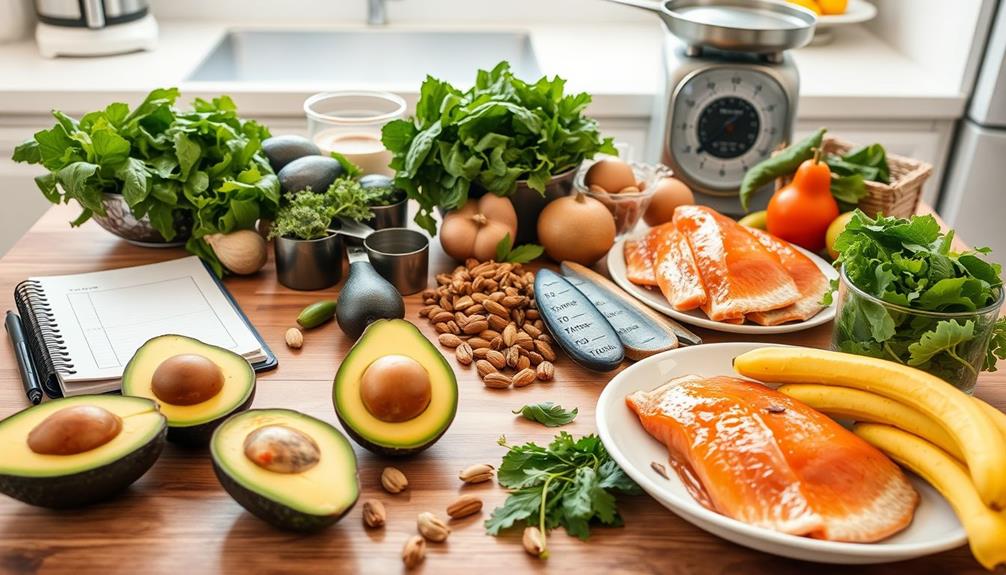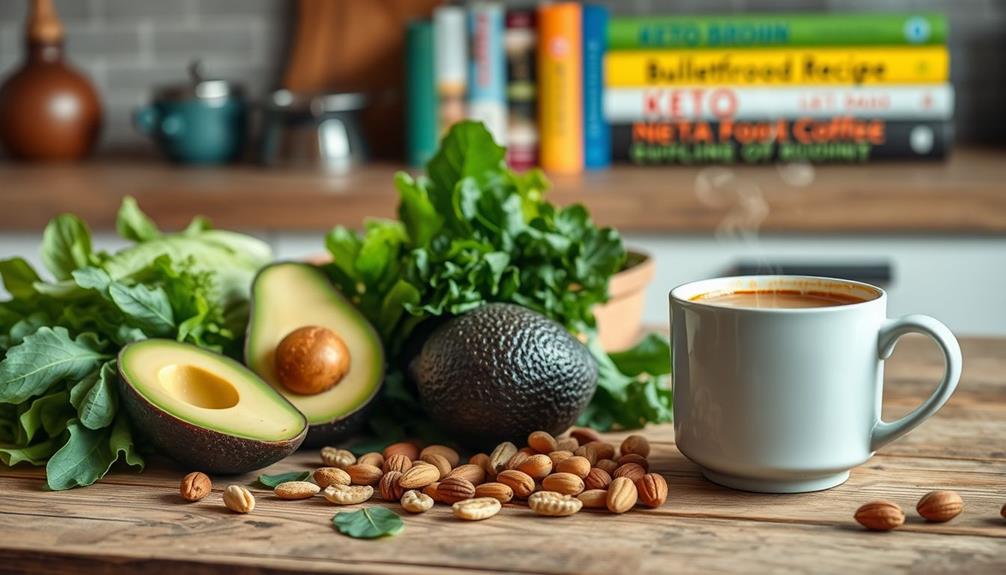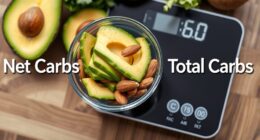Mastering your keto shift means strategically reducing carbs to 20-50 grams daily to help your body enter ketosis. Start slowly, monitoring your cravings and symptoms like "keto flu." Focus on high-fat, low-carb foods such as avocados, olive oil, and fatty fish while avoiding bread, pasta, and sugary snacks. Staying hydrated and replenishing electrolytes is vital during this phase. Plan meals in advance to avoid unhealthy choices. This shift can be challenging at first, but with the right strategies, you'll feel more energized and satisfied. There's much more to take into account as you adjust to this diet successfully.
Key Takeaways
- Gradually reduce carbohydrate intake over one to two weeks to ease into ketosis and minimize cravings.
- Monitor hydration and replenish electrolytes like sodium, potassium, and magnesium to combat keto flu symptoms.
- Prepare meal plans focusing on healthy fats and low-carb foods to support your dietary transition.
- Engage with keto communities for support, tips, and shared experiences during your transition.
- Track macronutrients using apps to maintain awareness of carb, fat, and protein intake for optimal results.
Overview of the Keto Diet

The ketogenic diet is often praised for its ability to transform how your body uses energy. By considerably reducing carbohydrate intake to about 20-50 grams per day, you shift your body into a state of ketosis, where it burns fat instead of carbs for fuel.
This diet primarily focuses on healthy fats—think avocados, nuts, and oils—while also including moderate protein from sources like meat and fish. As you cut carbs, your insulin levels drop, allowing fat stores to be utilized more effectively.
Additionally, incorporating effective strategies for weight loss can help enhance your results on the keto diet. Common goals of the keto diet are weight loss, improved blood sugar control, and enhanced metabolic health.
Health Benefits of Keto

Keto enthusiasts often highlight the impressive health benefits that come with this diet. By considerably reducing carbs, you can experience effective weight loss and improved blood sugar control. Many find their energy levels stabilize, leading to consistent productivity throughout the day. Moreover, the diet may enhance heart health by lowering triglycerides and increasing good cholesterol.
| Health Benefit | Description |
|---|---|
| Weight Loss | Reduces hunger, leading to a natural calorie deficit. |
| Blood Sugar Control | Stabilizes insulin levels and improves sensitivity. |
| Heart Health | Lowers triglycerides and increases HDL cholesterol. |
| Cognitive Benefits | Ketones fuel the brain, enhancing clarity and focus. |
Steps for a Smooth Transition

Adopting a keto lifestyle can be a rewarding journey, but getting there smoothly requires some planning. Start by gradually reducing your carbohydrate intake over a week or two. This helps your body adjust and minimizes "keto flu" symptoms like fatigue and headaches.
It's also essential to monitor your body's response to dietary changes, as some individuals may experience increased cravings or digestive issues at first, which can be managed by focusing on nutritional guidelines that support your changeover.
Next, create a meal plan focusing on high-fat, low-carb foods, and prep your meals to avoid unhealthy choices. Stay hydrated and replenish electrolytes—sodium, potassium, and magnesium are key to easing side effects.
Essential Foods for Keto

When shifting to a keto lifestyle, stocking up on essential foods can make all the difference in your success. Focus on incorporating healthy fats, quality proteins, and low-carb vegetables into your meals. Here's a handy list to guide your grocery shopping:
| Healthy Fats | Protein Sources | Low-Carb Vegetables |
|---|---|---|
| Avocado | Grass-fed beef | Spinach |
| Olive oil | Chicken | Broccoli |
| Coconut oil | Fatty fish | Zucchini |
| Butter | Eggs | Cauliflower |
| Nuts (almonds) | Pork | Bell peppers |
With these essentials, you'll have a solid foundation for your keto journey, enabling you to create delicious, satisfying meals that keep you on track.
Foods to Avoid
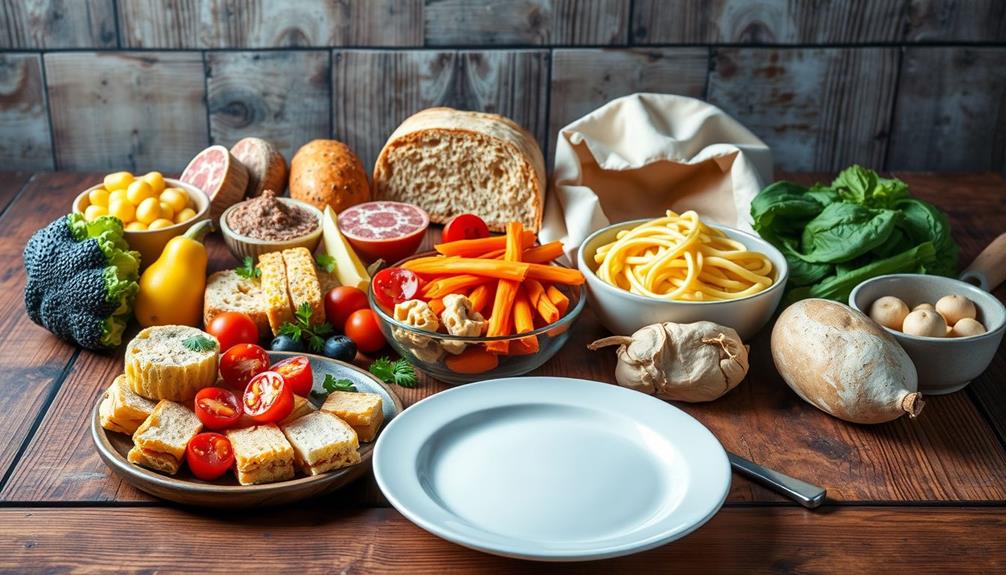
To successfully navigate your keto journey, steering clear of certain foods is essential for maintaining ketosis. By avoiding high-carb options, you'll help your body stay in fat-burning mode.
A solid understanding of common financial terms can help you budget effectively for your keto lifestyle. Here are some foods you should eliminate:
- Bread and pasta
- Rice and grains
- Sugary snacks and desserts
- Starchy vegetables like potatoes and corn
- Sauces and dressings with hidden sugars
These items can easily sabotage your progress, so it's vital to read labels and be mindful of what you're consuming.
Focus on whole, unprocessed foods to keep your carb intake low and enjoy your keto experience to the fullest.
Managing Keto Flu Symptoms

Keto flu symptoms can be a challenging hurdle during your shift to a ketogenic lifestyle. To manage these effects, stay well-hydrated; increasing your water intake helps alleviate fatigue and headaches.
Don't forget about electrolytes—ensure you're getting enough sodium, potassium, and magnesium, either through food or supplements.
Gradually reduce your carbohydrate intake instead of cutting it all at once, which can ease your body's changeover. Incorporating healthy fats and moderate protein in your meals can also provide sustained energy.
Finally, listen to your body; rest is essential. If you feel overwhelmed, consider reaching out to online keto communities for support and tips.
Long-term Keto Strategies
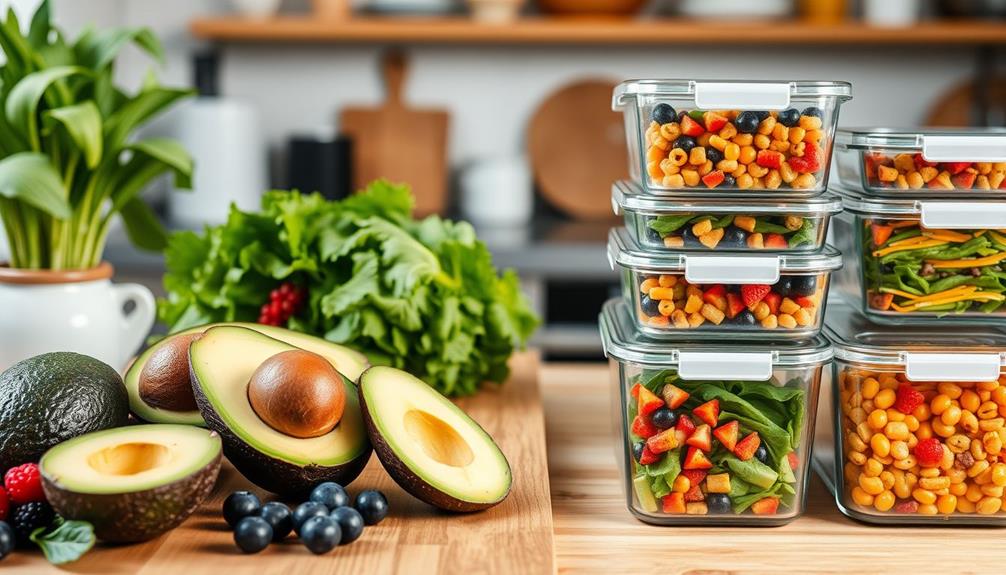
Successfully maintaining a ketogenic lifestyle requires thoughtful planning and strategies that adapt to your evolving needs.
To guarantee long-term success, consider these essential tactics:
- Track Your Macronutrients: Use apps to monitor your carb, fat, and protein intake.
- Meal Prep: Plan and prepare meals in advance to avoid impulse eating.
- Stay Hydrated: Drink plenty of water to support overall health and manage cravings.
- Experiment with Foods: Discover new keto-friendly recipes to keep your meals exciting.
- Listen to Your Body: Pay attention to how different foods affect your energy and mood, adjusting as necessary.
Implementing these strategies will help you stay committed and make the keto diet a sustainable part of your lifestyle.
Exercise and Keto Compatibility

Finding the right balance between exercise and a ketogenic diet can greatly enhance your results and overall well-being.
While adapting to keto, it's essential to listen to your body. Initially, you might experience decreased energy during high-intensity workouts. Focus on low to moderate exercises like walking, cycling, or yoga to maintain activity without overwhelming your system.
As your body adjusts to fat as fuel, you can gradually increase workout intensity. Incorporating strength training is also beneficial, as it helps preserve muscle mass.
Stay hydrated and consider electrolyte supplements to combat fatigue.
Ultimately, consistency in both diet and exercise will lead to the best results, so find a routine that suits you and stick with it.
Frequently Asked Questions
Can I Take Supplements While on the Keto Diet?
Yes, you can take supplements while on the keto diet.
In fact, certain supplements like electrolytes, magnesium, and omega-3 fatty acids can support your shift and help alleviate symptoms of the "keto flu."
Just make certain to choose high-quality options and check for hidden sugars or carbs in the ingredients.
Always consult with a healthcare professional before starting any new supplements to guarantee they fit your individual needs and goals.
How Do I Handle Dining Out on Keto?
Did you know that over 60% of people on a keto diet find dining out challenging?
When you're eating out, look for options like salads with grilled proteins and healthy fats.
Don't hesitate to ask for modifications, like swapping fries for veggies.
Avoid breaded items and sugary sauces.
Many restaurants offer keto-friendly choices, so stay focused on your goals, and enjoy your meal without feeling deprived!
Keeping it simple helps you stick to your plan.
Is Keto Safe for Everyone?
Keto isn't safe for everyone. While many thrive on this low-carb, high-fat diet, individuals with certain medical conditions, like pancreatitis or liver disease, should avoid it.
Pregnant or breastfeeding women may also need to be cautious. It's essential to consult a healthcare professional before starting.
If you have any underlying health issues or concerns, make certain to get personalized advice to guarantee a safe and effective approach to your dietary changes.
What Are Some Common Keto Meal Prep Ideas?
Imagine stepping into a culinary adventure where flavors dance and health reigns supreme.
When meal prepping for keto, think hearty zucchini noodles topped with creamy avocado pesto, or savory egg muffins bursting with spinach and cheese.
Roast vibrant bell peppers stuffed with seasoned ground beef, and whip up a luscious cauliflower mash to replace traditional carbs.
Don't forget to stock up on snacks like nuts and cheese for those tempting moments between meals!
How Can I Track My Progress on Keto?
To track your progress on keto, start by measuring your weight weekly and noting any changes in body measurements.
Keep a food journal to log your meals, focusing on macronutrients—carbs, fats, and proteins.
You can also use keto apps to track your intake and monitor ketosis levels with ketone test strips.
Regularly assess your energy levels, mood, and overall health to see how the diet affects you.
Adjust your plan as needed!
Conclusion
As you embrace your keto journey, remember that each step brings you closer to a healthier, more vibrant you. The transformation may feel like turning into a superhero with endless energy and focus! Stay committed to your goals, keep experimenting with delicious recipes, and don't shy away from seeking support when needed. With these insights in hand, you're not just surviving the keto change; you're thriving! Now go out there and conquer your keto adventure! Additionally, take the time to master keto cravings by finding satisfying alternatives to your favorite high-carb snacks. Remember, it’s all about finding balance and staying mindful of your choices. By staying proactive and committed to your keto journey, you’ll continue to see incredible results and feel empowered in your newfound healthier lifestyle. So, keep pushing forward and conquering your keto adventure with confidence and determination!


